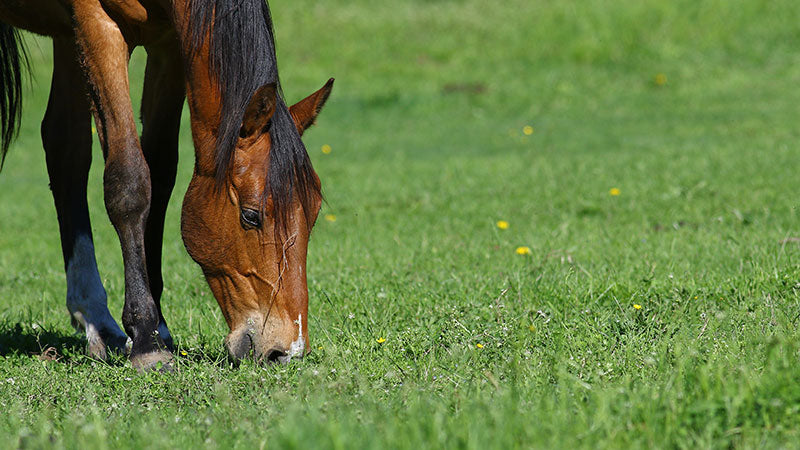Preventing Springtime Laminitis / Founder
Laminitis or founder is one of the most dreaded diagnoses in the horse world. The destruction of the connective tissues within the foot (laminae), combined with the muscle forces that pull on the coffin bone, can separate the bone from the hoof wall. This can cause excruciating pain and often leads to permanent unsoundness. Cases may be severe enough that euthanasia is warranted to relieve suffering. Unfortunately, most treatment options are ineffective, but there are ways to make it less likely that your horse could fall victim to this diagnosis.
The most important thing to do is to identify at-risk horses. Horses that can be prone to springtime laminitis are ponies, donkeys, minis, horses prone to insulin resistance and pregnant mares. They are often “easy keepers” who gain weight even with little or no grain in their diets. They can be obese or exhibit “regional adiposity”, the development of fat deposits in distinct areas, even if they are not overweight. They may be “cresty,” with fat accumulating along the crest of the neck, and may also have unusual pads of fat over the trailhead, behind the shoulders or near the sheath or mammary glands. Another sign may be distinct growth rings on the hoof walls that show previous episodes of laminitis. Talk to your veterinarian if your horse fits this profile; blood tests can determine if they are insulin resistant.
Limiting access to spring pastures may be effective. But, if you have a vulnerable horse, you may need to eliminate spring grazing altogether. Grazing lush springtime pasture grasses, which are rich in a sugar called fructan, is a well-established cause of laminitis in at-risk horses. Fructan levels tend to peak in spring and fall but can fluctuate throughout the year. Sending a grass sample to a laboratory for analysis is the surest way to be certain of it sugar content. Your veterinarian can help you locate a suitable facility and understand the results.
How much grazing is “too much” depends on the individual horse. Knowing what your pasture fructan levels are, and how and when they vary, your veterinarian can help you develop a turnout schedule that suits your horse’s needs. You may need to use a grazing muzzle to limit his intake during peak periods of grass growth or eliminate spring grazing altogether depending on how sensitive your horse is.
Hays can also have varying levels of fructan. Cool-season grasses and hays, such as fescue, rye, and bluegrass, tend to be higher in sugar than warm-season grasses such as Bermuda or switchgrass. If your horse’s dietary needs are strict, you may need to send samples from every new load to a laboratory for testing. An all-hay diet with a low-calorie ration balancer or a vitamin and mineral supplement is safest for a horse whose NSC intake must be closely controlled.
Prevent starch overloads. If any horse eats more starch or sugars than his stomach can digest all at once, the excess nutrients pass into the intestine and hindgut, where they ferment and produce byproducts that trigger inflammation in the gut wall and ultimately can lead to laminitis. Feeding hay first, and then the grain can fill his stomach with fiber, which will slow the grain down so it can be digested more thoroughly.
And lastly, make dietary changes gradually. Sudden changes in a horse’s diet can disrupt the intestinal flora---the populations of “good” bacteria that aid digestion, immunity, and other functions---which can lead to laminitis. When introducing any new feed, including hay, start by blending only a small amount into the horse’s existing feed, then gradually increase the proportion of new to old over the course of at least a week.
Taking precautions and finding out if your horse is at risk can have a great impact on avoiding laminitis/founder and keep your horse happy and healthy through every season.
If you think your horse might be at risk you should contact your Veterinarian strait away.
Has your horse ever had issues with laminitis, navicular, side or ringbone? Learn more about hoof wear that will help your horse stay comfortable and sound.

